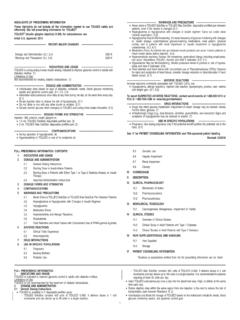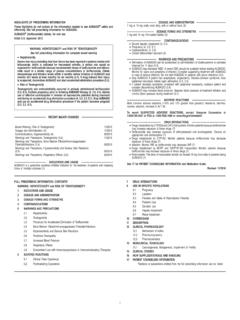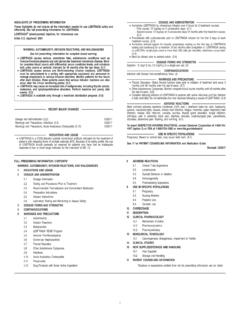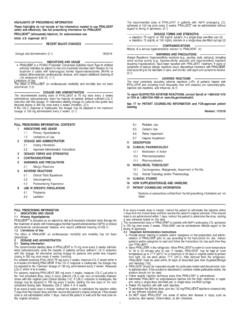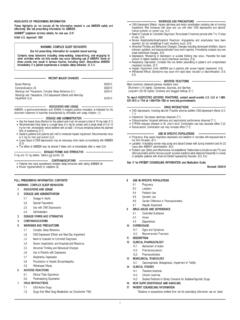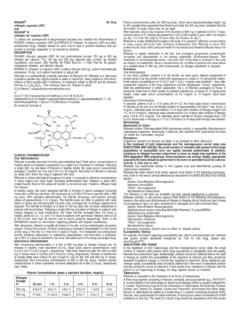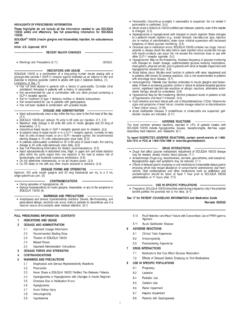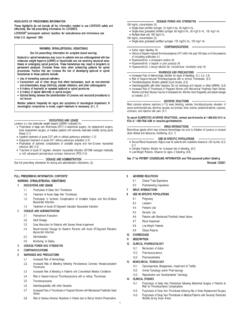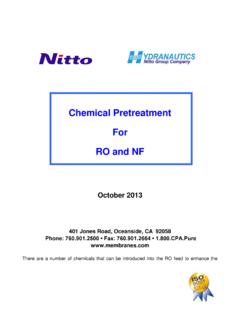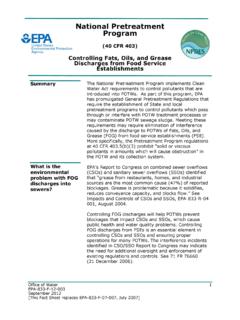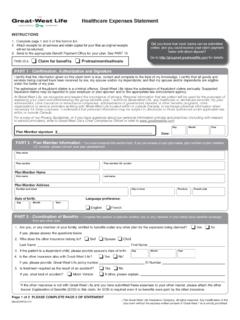Transcription of HIGHLIGHTS OF PRESCRIBING INFORMATION Infusion …
1 HIGHLIGHTS OF PRESCRIBING INFORMATION Infusion -associated reactions occurred in 59% of patients during Fabrazyme administration in These HIGHLIGHTS do not include all the INFORMATION needed to use Fabrazyme safely and clinical trials. Some reactions were severe. In patients experiencing Infusion -associated effectively. See full PRESCRIBING INFORMATION for Fabrazyme. reactions, pretreatment with an antipyretic and antihistamine is recommended. If an Infusion - associated reaction occurs, decreasing the Infusion rate, temporarily stopping the Infusion , FABRAZYME (agalsidase beta) for injection, for intravenous use and/or administrating additional antipyretics, antihistamines, and/or steroids may ameliorate Initial Approval: 2003 the symptoms. ( ). If severe Infusion -associated reactions occur, immediate discontinuation of the administration INDICATIONS AND USAGE of Fabrazyme should be considered and appropriate medical treatment should be initiated.
2 Fabrazyme is indicated for use in patients with Fabry disease. Fabrazyme reduces globotriaosyl- Severe reactions are generally managed with administration of antihistamines, corticosteroids, ceramide (GL-3) deposition in capillary endothelium of the kidney and certain other cell types. (1) intravenous fluids, and/or oxygen as clinically indicated. ( ). Patients with advanced Fabry disease may have compromised cardiac function, which may DOSAGE AND ADMINISTRATION predispose them to a higher risk of severe complications from Infusion -associated reactions, The recommended dosage is 1 mg/kg body weight given every two weeks as an intravenous and these patients should be monitored closely during Fabrazyme administration. ( ). Infusion . ( ) Readministration of Fabrazyme to patients who have previously experienced severe or serious Administer antipyretics prior to Infusion .
3 ( ) allergic reactions to Fabrazyme should be done only after careful consideration of the risks and See the full PRESCRIBING INFORMATION for the recommended Infusion rate. ( ) benefits of continued treatment, and only under the direct supervision of qualified personnel DOSAGE FORMS AND STRENGTHS and with appropriate medical support measures readily available. ( ). For injection: 5 mg or 35 mg lyophilized cake or powder in a single-dose vial for reconstitution (3) ADVERSE REACTIONS . CONTRAINDICATIONS Most common adverse reactions ( 20% and > compared to placebo) are: upper respiratory None. (4) tract infection, chills, pyrexia, headache, cough, paresthesia, fatigue, peripheral edema, dizziness, and rash. ( ). WARNINGS AND PRECAUTIONS . Life-threatening anaphylactic and severe allergic reactions have been observed in some To report SUSPECTED ADVERSE REACTIONS, contact Genzyme at 1-800-745-4447 or FDA.
4 Patients during Fabrazyme infusions. If severe allergic or anaphylactic reactions occur, at 1-800-FDA-1088 or immediately discontinue administration of Fabrazyme and provide necessary emergency treatment. Appropriate medical support measures should be readily available when Fabrazyme See 17 for PATIENT COUNSELING INFORMATION . is administered because of the potential for severe Infusion -associated reactions. ( ) Revised: 12/2018. FULL PRESCRIBING INFORMATION : CONTENTS* 8 USE IN SPECIFIC POPULATIONS. 1 INDICATIONS AND USAGE Pregnancy 2 DOSAGE AND ADMINISTRATION Lactation Recommended Dosage Pediatric Use Preparation and Administration Instructions Geriatric Use 3 DOSAGE FORMS AND STRENGTHS Responses in Women 4 CONTRAINDICATIONS 10 OVERDOSAGE. 11 DESCRIPTION. 5 WARNINGS AND PRECAUTIONS. 12 CLINICAL PHARMACOLOGY. Anaphylaxis and Allergic Reactions Mechanism of Action Infusion -associated Reactions Pharmacodynamics Compromised Cardiac Function Pharmacokinetics Immunogenicity and Rechallenge 13 NONCLINICAL TOXICOLOGY.
5 Monitoring: Laboratory Tests Carcinogenesis, Mutagenesis, Impairment of Fertility 6 ADVERSE REACTIONS 14 CLINICAL STUDIES. Clinical Trials Experience 16 HOW SUPPLIED/STORAGE AND HANDLING. Immunogenicity 17 PATIENT COUNSELING INFORMATION . Postmarketing Experience *Sections or subsections omitted from the full PRESCRIBING INFORMATION are not listed FULL PRESCRIBING INFORMATION weight (kg) and the recommended dose of 1 mg/kg. 1 INDICATIONS AND USAGE Select a combination of 35 mg and 5 mg vials so that the total number of mg is equal to or greater Fabrazyme is indicated for use in patients with Fabry disease. Fabrazyme reduces globotriaosylce- than the patient's number of kg of body weight. ramide (GL-3) deposition in capillary endothelium of the kidney and certain other cell types. 2. Reconstitute each 35 mg vial of Fabrazyme by slowly injecting mL of Sterile Water for 2 DOSAGE AND ADMINISTRATION Injection, USP down the inside wall of each vial.
6 Roll and tilt each vial gently. Each vial will yield Recommended Dosage a 5 mg/mL clear, colorless solution (total extractable amount per vial is 35 mg, 7 mL). The recommended dosage of Fabrazyme is 1 mg/kg body weight infused every two weeks as an Reconstitute each 5 mg vial of Fabrazyme by slowly injecting mL of Sterile Water for Injection, intravenous Infusion . The initial intravenous Infusion rate is no more than mg/min (15 USP down the inside wall of each vial. Roll and tilt each vial gently. Each vial will yield a 5 mg/mL. mg/hour). Slow the Infusion rate in the event of Infusion -associated reactions [see Warnings and clear, colorless solution (total extractable amount per vial is 5 mg, 1 mL). Precautions ( )]. Administer antipyretics prior to Infusion of Fabrazyme [see Warnings and Precautions ( )]. 3. Visually inspect the reconstituted vials for particulate matter and discoloration.
7 Do not use the After patient tolerance to the Infusion is well established, increase the Infusion rate in increments reconstituted solution if there is particulate matter or if it is discolored. of to mg/min (increments of 3 to 5 mg/hour) with each subsequent Infusion . 4. The reconstituted solution should be further diluted with Sodium Chloride Injection, USP to The maximum Infusion rate for patients weighing less than 30 kg, is mg/minute (15 mg/hour). a total volume based on patient weight specified in Table 1 below. Prior to adding the volume of For patients weighing 30 kg or greater, the minimum Infusion duration is hours (based on reconstituted Fabrazyme required for the patient dose, remove an equal volume of Sodium individual patient tolerability). Chloride Injection, USP from the Infusion bag. Patients who have had a positive skin test to Fabrazyme or who have tested positive for anti-Fabrazyme IgE may be successfully rechallenged with Fabrazyme.
8 The initial rechallenge Table 1. administration should be a low dose at a lower Infusion rate, , 1/2 the therapeutic dose ( Patient Weight (kg) Minimum Total Volume (mL). mg/kg) at 1/25 the initial standard recommended rate ( mg/min). Once a patient tolerates the Infusion , the dose may be increased to reach the approved dose of 1 mg/kg and the Infusion rate 35 50. may be increased by slowly titrating upwards (doubled every 30 minutes up to a maximum rate of mg/minute), as tolerated. 70 100. Preparation and Administration Instructions 100 250. Fabrazyme does not contain any preservatives. Vials are for single use only. Discard any unused product. >100 500. Avoid shaking or agitating this product. Do not use filter needles during the preparation of the Infusion . Patient dose (in mg) 5 mg/mL = Number of mL of reconstituted Fabrazyme required for patient Reconstitution and Dilution (using Aseptic Technique) dose 1.
9 Allow Fabrazyme vials and diluent to reach room temperature prior to reconstitution (approxi- Example: Patient dose = 80 mg mately 30 minutes). The number of 35 mg and 5 mg vials needed is based on the patient's body 80 mg 5 mg/mL = 16 mL of Fabrazyme 1. Slowly withdraw the reconstituted solution from each vial up to the total volume required for the The data described below reflect exposure of 80 patients, ages 16 to 61 years, to 1 mg/kg Fabrazyme patient dose. Inject the reconstituted Fabrazyme solution directly into the Sodium Chloride every two weeks in two separate double-blind, placebo-controlled clinical trials, for periods ranging from solution. Do not inject in the airspace within the Infusion bag. Discard any vial with unused 1 to 35 months (mean months). All 58 patients enrolled in one of the two studies continued into reconstituted solution.
10 An open-label extension study of Fabrazyme treatment for up to 54 additional months. Patients were 5. Gently invert Infusion bag to mix the solution, avoiding vigorous shaking and agitation. treated with antipyretics and antihistamines prior to the infusions. 6. Do not infuse Fabrazyme in the same intravenous line with other products. Most Common Adverse reactions 7. Administer Fabrazyme using an in-line low protein binding m filter. Table 2 enumerates adverse reactions that occurred during the double-blind treatment periods of the Storage two placebo-controlled trials (Study 1 and Study 2) [see Clinical Studies (14)]. The most common Use reconstituted and diluted solutions of Fabrazyme immediately. If immediate use is not possible, the reconstituted and diluted solution may be stored for up to 24 hours at 2 C to 8 C (36 F to 46 F).

